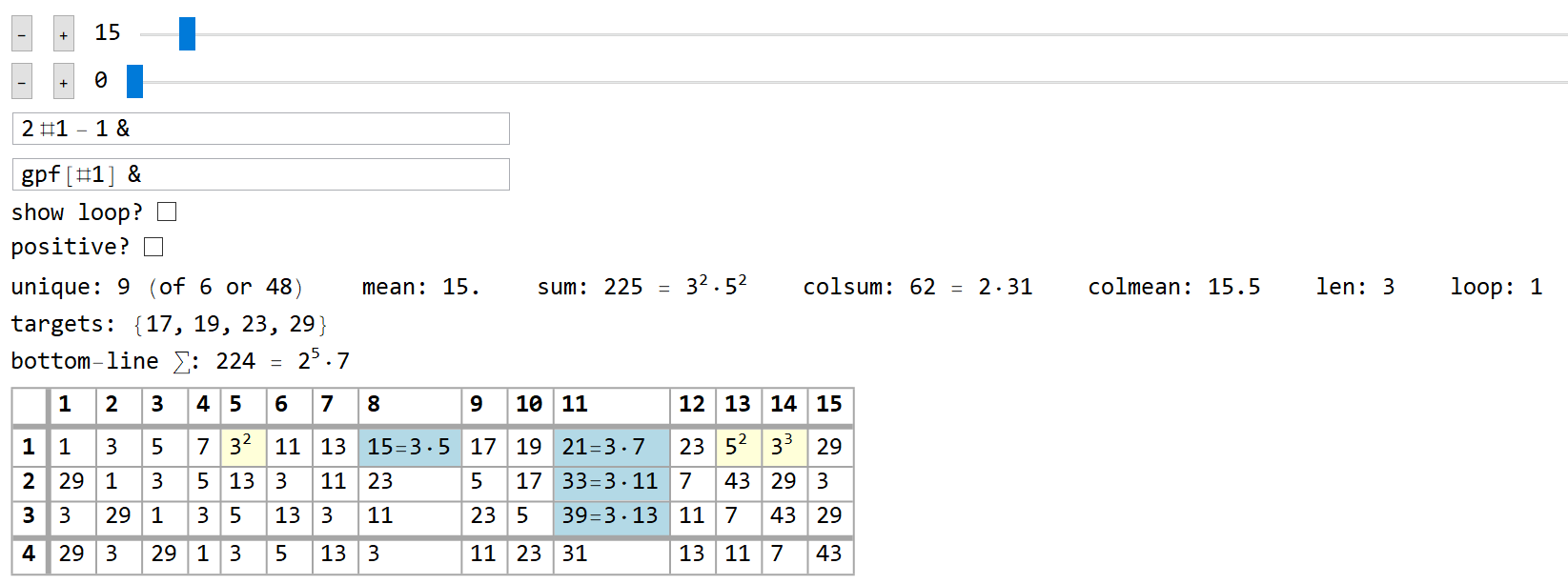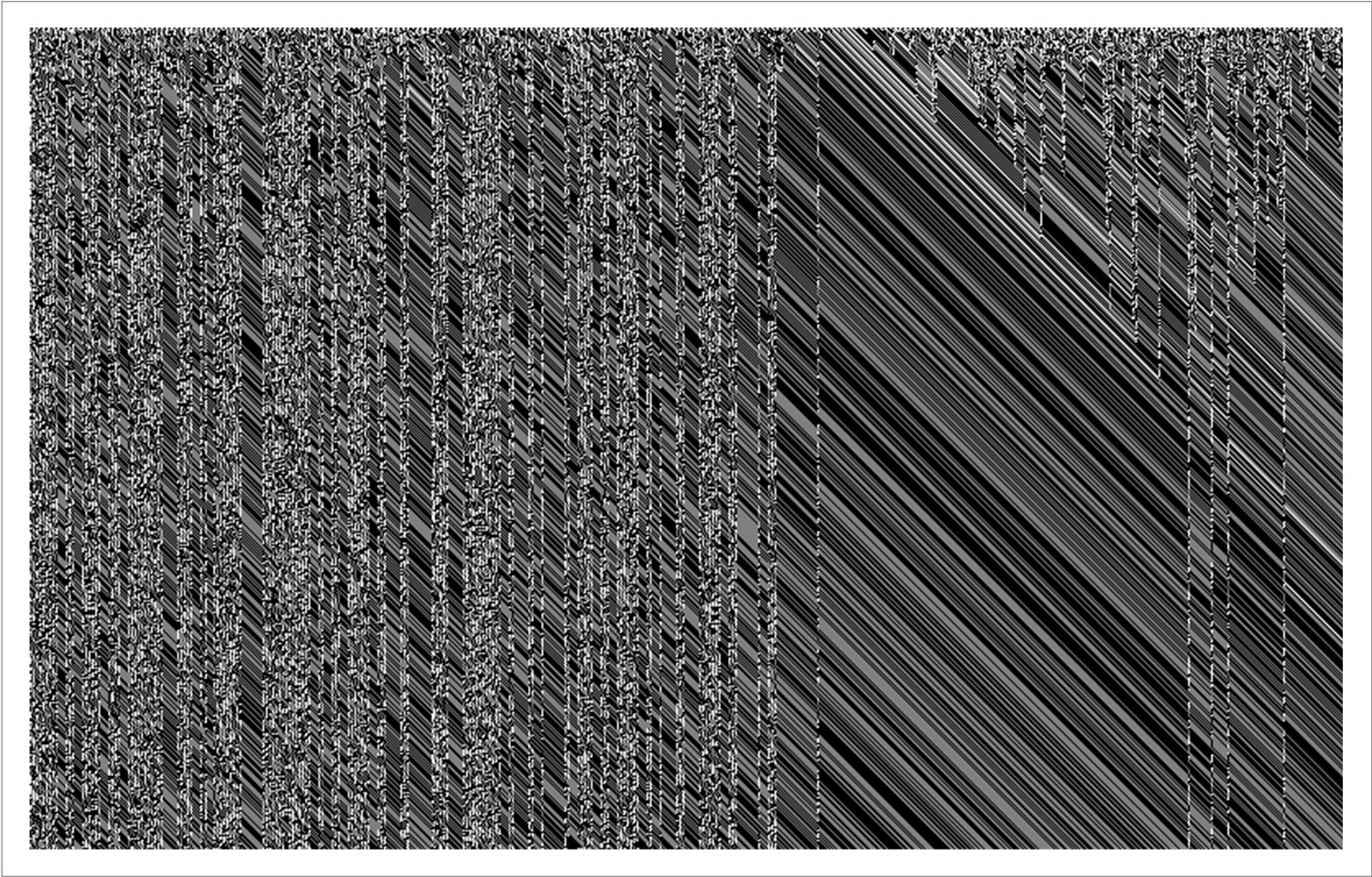factor pushing
Factor pushing is an idea I came up with when trying to establish an easy proof of the existence of a prime in $(n,n^2)$. I haven’t managed that yet, but it’s still on my bucket list.
To do it, you take some set of numbers, write them out in a row, and then generate new rows with a simple transform. Typically, this transform is just to additively shift the gpf (greatest prime factor) of a number to its right. Or if you prefer,
$$n_i \leftarrow n_{i} – \textrm{gpf}(n_i) + \textrm{gpf}(n_{i-1}),$$
where typically the number of columns is fixed and the values effectively wrap around.
The concept is to tease out prime values by hashing things around until they settle into place. Since the gpf of a prime number is simply that number, the transform causes primes to travel unchanged along a diagonal until they hit a composite. Moreover, there are two important unchanging properties to the whole setup:
- The sum of any given row is fixed.
- Once a column has a prime value, it will always have a prime value.

In the example above, composites are highlighted blue, everything else is prime (or 1). As only composites are affected, the first change worth noticing is in column 5, corresponding to $3^2=9$. It additively loses a 3, which is emitted to the right on the next row, which leaves a 6, which combines with the incoming 7 from the left to yield 13. The upshot is that what was previously $7,9$ has been reshuffled to be $13,3$, having the same total but now both prime. Like so:
| $1$ | $3$ | $5$ | $7$ | $9$ | $11$ |
| $\dots$ | $3-3+1=1$ | $5-5+3=3$ | $7-7+5=5$ | $9-3+7=13$ | $11-11+3=3$ |
You continue the process until it repeats, which signifies either all primes, or catastrophic failure. Given a suitable configuration, it’s pretty clear this will always work, but proving it seems hard. W.r.t. the motivating idea, proving the existence of a prime in $(n,n^2)$ for any $n$, you would need only plug in the first $n$ odd integers. Since they sum to $n^2$, and there are $n$ values, then if every value is prime, at least one of those must be in that range simply because the mean value is $n$, immediately ensuring at least one value larger and one value smaller than that (barring using all $n$’s).
It turns out there are lots of neat effects you see depending on the exact sort of set you provide. Of particular note is what happens when even numbers are included.
You’ll notice values of $2$ are green and prime powers are beige. Using the standard transform, a group of odd numbers can never develop an even number: each step, an odd number will be subtracted, and an odd number will be added, leaving the parity unchanged. This is because only primes that are present as a factor in one of the values will be in play, so if no twos exist anywhere as a factor at the outset, they never will.
When even numbers are included, as in the example above, you’ll notice that those columns which start out even tend to be composite for much longer than their odd counterparts. This is because if parity is typically left unchanged, and a number has a factor of $2$, there are only two ways to get rid of it:
- Have a $2$ to its left.
- Through its random-walk-like navigation of integers, land on a prime power of $2$.
Both things will flip the parity of the number, with one important difference. If a $2$ comes in from the left, that $2$ is effectively consumed and stops traveling along, either by annihilating an existing factor of $2$ in the composite number, or if the composite is odd, being absorbed to make it even. If instead a column spontaneously finds some $2^k$, then it will be odd thereafter, but will also emit a $2$, since that’s its largest factor.
The subjective effect reminds me of particles and antiparticles. You can see in the table above how composite columns every once in a while spontaneously emit a $2$ particle after finding a prime power, which then travels along until it encounters some other even composite column, whereupon they cancel each other out. You get truly enormous sets of primes out of this under the right conditions. More interestingly to me, just by inspecting the table, you might notice that this property pairs up all the even columns: each one is the emitter or receiver of a $2$ at least once. In fact, every even number can easily be paired with exactly one other number, even in seemingly more complicated situations.
In the table above, $28$ is paired with $34$. This is because $28$ finds $2^5$, emits a $2$, which then hits column $36$, but connects backwards to $34$, which had its own particle emission. If you think of this in terms of 1s and 0s, there’s a clear unbroken line connecting the first value in each column. These lines cannot cross: any even number inside the range of a connected pair must have its own partner also in that range.
If you do render this sort of situation as 0s and 1s, and plot it, you get something like this:
This is the first however-many integers, just as in the table earlier, but simply showing black for odd values and white for even values. The pairing up is pretty clear here. Note that in this version, I’m not using a wrap-around finite sequence, but rather a finite range of values which doesn’t wrap around, but does import from the left and export to the right, so to speak. You’ll notice a few lines extending all the way to the bottom: these signify columns that are remaining composite and even for longer than was practical to calculate or render. Theoretically, however, every line must eventually terminate in a connection to some other line, somewhere. In the finite wrap-around setup, the same is true, although if you start with an odd number of even numbers, you’ll have one left over, which presents as there being a single $2$ in the resulting row of primes.
At the time I was doing this, I did play around with a number of variants for visualizing the same or similar setups. The smoother ones are from using logs on a similar approach using lpf instead of gpf; in the wide one, you can clearly see the transition between negative and positive integers. The relative brightness indicates more composite activity in the negatives, something that is even starker in the final picture, which is what it looks like if you look at factors of $3$ instead of $2$.








